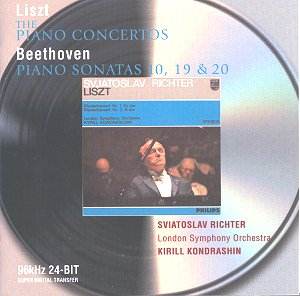 |
Franz LISZT Piano Concerto no. 1 in E flat Piano Concerto no. 2 in A Ludwig van BEETHOVEN Piano Sonatas: op. 14/2 in G, op. 49/1 in G minor, op. 49/2 in G Recorded in London, July 1961 (Liszt), 1963 (Beethoven) Crotchet AmazonUK AmazonUS Amazon recommendations |
This famous Liszt coupling presents the demonic genius of Richter as he first flashed upon the Western world. The technical address is hair-raising at times, as he flings massive volcanic energy out of his instrument (with never a trace of hardness in the tone, note). But he can also be delicate and brings the most exquisite poetry to the more intimate passages, especially in the A major. Above all, he is fiercely committed to the music, the virtuosity is only a means to an end. Given a like-minded conductor these must be among the greatest performances the concertos have ever had. The recording is still fairly acceptable - just a touch strident in the orchestral tuttis and the solo string musings in the A major are too closely miked.
Trust Richter to take what some might think of as Beethoven's three least interesting sonatas and lavish all his art on them. The first movement of op. 14/2 sometimes scampers ahead of itself but he extracts a wealth of colour and pre-Schumannesque poetry from a slow movement which looks (and can sound) very bland, while the finale is a scintillating display, revealing that there was even a trace of humour behind Richter's granitically forbidding countenance. The amazing thing about the op. 49 sonatas is how very complete their sonority sounds, with no suggestion that this is "easy" music. Young pianists are warned not to try the first movement of the G minor at Richter's slow tempo - he extracts a rare expressiveness from it which not many other pianists could achieve. But all aspiring youngsters should have their attention drawn to the relationship between accompaniment and melody at the start of the minuet from no. 2 and at least make some attempt to imitate it, just as all of us might try to play the finale of no. 1 with a trace - however little - of Richter's wit and sheer sense of timing.
Christopher Howell